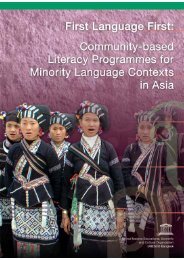Part II.pdf - MTB-MLE Network
Part II.pdf - MTB-MLE Network
Part II.pdf - MTB-MLE Network
You also want an ePaper? Increase the reach of your titles
YUMPU automatically turns print PDFs into web optimized ePapers that Google loves.
As for adult and continuing education, people prefer to use oral Lahu, but they think that it is<br />
unnecessary to learn the writing system. According to a 2002 survey in Nanuoke and Banli villages,<br />
researchers from RTCLE found that among 18-50 year olds, almost no one can correctly use the<br />
Lahu written language. Most of the villagers think that the writing system has no practical use.<br />
They prefer to learn Chinese immediately. Most of the learning materials in science, technology<br />
and health have been developed in Chinese, and some new words about new technology do not<br />
have counterparts in Lahu. During their literacy learning, there is no structured bridge from Lahu<br />
to Chinese.<br />
Literacy facilitators<br />
There are few La-Han bilingual teachers at the project sites. The lack of qualified bilingual teachers<br />
is a serious problem. Few local teachers can speak the Lahu language because most of them are<br />
not Lahu people. In this situation, it is quite difficult to keep illiterate learners in literacy classes.<br />
It is common knowledge that most of the literacy facilitators are teachers of local primary schools<br />
who also teach adult illiterates. The teachers do not really know how to teach adult literacy classes,<br />
and do not have special training. They do not understand bilingual teaching methods and the<br />
characteristics of adult learning. As has been mentioned, most of the literacy learners are adults<br />
who have rich experience that can be a resource for their learning, and they primarily are interested<br />
in content that is closely related to their lives. The teaching methodology for adult literacy should,<br />
hence, differ from that for children.<br />
Inappropriate methods adopted by literacy facilitators may lessen learner interest and motivation<br />
to participate in literacy classes. The teachers should have training in bilingual literacy teaching<br />
in order that they can more effectively help the learners.<br />
6. Target Learners and Objectives of Bilingual Literacy<br />
Classes<br />
Based on the analysis of research materials concerning bilingual literacy for the Lahu people, field<br />
surveys, language situation analysis and assessment of Lahu language (including spoken and written<br />
language), the target learners and project objectives are as follows:<br />
• Target learners<br />
The target learners are adult illiterates and semi-illiterates (mainly 15-50 year olds) with<br />
basic motivation for literacy learning. Women are particularly encouraged to participate<br />
in the bilingual literacy project.<br />
• Objectives of bilingual literacy teaching<br />
With about 1 to 2 years’ study, the objectives of the literacy teaching are that:<br />
– community members of project villages will show more respect for their own<br />
language and realize the importance and value of the mother tongue in the process<br />
of learning Chinese;<br />
– Lahu illiterates, especially women, will bridge from learning in the mother tongue<br />
to Chinese language learning, and strategies for better learning of these two<br />
languages will be developed;<br />
162
















